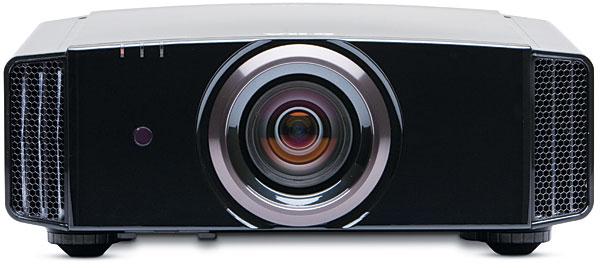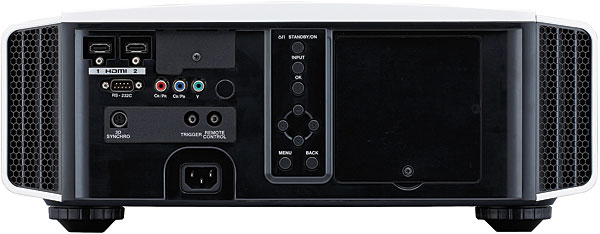JVC DLA-X3 D-ILA 3D Projector

Value to the Third Dimension
It’s no secret that we’ve become huge fans of JVC’s string of D-ILA projectors. Ever since the DLA-HD1 hit the market years ago, JVC has been a big player on the projector scene, with industry-leading native contrast and exceptional HD picture quality.
If you look at most of Home Theater’s writers’ reference systems, you’ll probably find a JVC model among the list of equipment used. While plenty of outstanding projection options are available today, it’s hard to ignore the performance and value that JVC has consistently delivered. This year, it’s gone one step further and brought the full high-definition 3D experience—and at a price far lower than expected.
For this review, I’ll look at the $4,495 DLA-X3, which is the entry-level option in JVC’s new trio of 3D-capable projectors (the DLA-X7 is $7,995, while the top-of-the-line DLA-X9 is a pricier $11,995). While its price is close to entry level, the DLA-X3’s performance is anything but. The DLA-X3 improves upon what we saw from last year’s JVC designs, with even better motion handling, a higher spec’d contrast ratio, and now 3D.
A New Beginning
The DLA-X3 is a completely new design for JVC, not a retooling of its previous models. The projector is housed in a new chassis that features a center-mounted lens and a larger lamp (220 watts versus the previous 200 watts). The DLA-X3 has an improved optical engine with a newly redesigned wire grid polarizer. This is said to eliminate some of the motion issues seen with the previous designs and improve contrast to a rated 50,000:1 without the use of a dynamic iris system. The DLA-X3 features a manual iris that you can use to balance light output with contrast. It lets you make the most of the projector in different room environments. I love this feature, as it lets me tailor the amount of light output I want for my dark room while gaining contrast at the same time.
The first thing I noticed when I unpacked the DLA-X3 was its size. The new design is substantially larger than JVC’s previous-generation projectors. You still get a lot of the functions of the previous design, including a motorized lens cover that slides into place when you power down the projector, plus fully motorized shift, focus, and zoom.
The biggest draw for me was the center-mounted lens. JVC’s past two projector generations had an offset lens, which makes placement trickier when you’re mounting the projector on a ceiling, as I do in my setup.
All of the inputs have been moved to the projector’s back panel. You get two HDMI inputs (HDMI 1.4a), one component video input, and one RS-232 input for remote control systems. The DLA-X7 and DLA-X9 models add an RGB HD15 input and LAN input. There are also controls on the back for navigating the menus and power-cycling the projector.

While the DLA-X3 supports full high-definition 3D playback, you won’t be able to dive right in out of the box. To take advantage of the 3D capabilities, you’ll need to buy the optional 3D emitter (PK-EM1, $79) and glasses (PKAG1, $179 each). The emitter sends the IR signal to the active shutter glasses and controls the sync. JVC designed the glasses to automatically turn on and off with the emitter, which makes for easy operation—no button or switch as with other glasses. The glasses were pretty comfortable, but less so if you have to wear them over your own glasses. I was a bit surprised at the price point of the glasses, which is on the high side even for active shutter glasses. Most shutter glasses from other manufacturers run about $150 each, which is still far from cheap. There are less expensive aftermarket active shutter glasses from XpanD that will work with the JVC emitter, but they’re cumbersome to use. To keep the cost of the projector down, JVC doesn’t include the emitter and glasses with the DLA-X3. This also gives you the ability to save costs if you aren’t interested in 3D playback.
The included remote control is largely the same as the previous line and includes one-press memory options for picture modes and inputs. The remote is backlit and provides easy access to all of the projector’s functions, including lens control and menus.
Making the Most of It
The DLA-X3’s setup was largely the same as the previous JVC D-ILA projector I’ve used. The setup menus are nearly identical, with only a few new options available for tailoring the image. Like the last line of D-ILA projectors, the DLA-X3 doesn’t need a lot of tweaking to produce a sensational image. A lot of the default settings are near their ideal placement, so it was easy to just make a few changes, then sit back and enjoy.
If you’re looking for a quick setup, you’ll probably want to stick with the Natural or Film memory presets. They seemed to track the closest to the Rec. 709 color gamut with the Standard Color Space preset selected. JVC also offers two Wide color preset options that bring the gamut quite a bit farther out than the reference Rec. 709 gamut. But even with the wider gamuts, the DLA-X3 does a nice job of balancing the color points. It offers a visible difference in saturation if you want more punch from your colors without the expense of gaudy fleshtones like we saw from the early D-ILA models. You can also force a Color Space input such as Y/Cb/Cr 4:2:2 or 4:4:4, although I didn’t see much difference in performance with either option. I just left mine in Auto.





























































